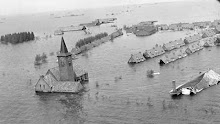Life list now 222 species
Added to Aden colony list: 14 species
Though the Salt Pans was my favourite birding spot in Aden, it was some distance away and I could visit only about once a week. However, during the autumn of 1946, I found another place much nearer in which I could bird watch every day if I wanted. This was Cemetery Valley. I passed through it several times each day, on the short walk between my billet and place of work - HQBF.
The map (taken from 1940s map) shows the location. I do not know who was buried in the cemetery but suspect that it was reserved for “natives” as we called the local inhabitants. The images below (photos by Roy Hopkins, 1952-53) shows the trajectory of the path along which I walked to and from work , the topography and habitat. The hillsides were bare rock but the valley floor was irrigated with waste water from the buildings on the hills on each side as well as from the (living) occupants of the valley. “Natives” had huts there and “dhobi wallahs” laundered the uniforms of the airmen. They cultivated small plots and a couple of dozen trees grew. This little oasis was very attractive to birds, especially to passerines during the migration seasons.
Above: Cemetery Valley looking west

Above: Cemetery Valley looking east with billet up hill on right
 Nowadays the oasis has disappeared as this Google satellite photo shows. The cemetery is still in place as are the structures that were formerly my billet and HQBF, but, what was bare rock, cultivation and trees is now covered with buildings.>>> to be continued
Nowadays the oasis has disappeared as this Google satellite photo shows. The cemetery is still in place as are the structures that were formerly my billet and HQBF, but, what was bare rock, cultivation and trees is now covered with buildings.>>> to be continued
My first observation here seems to have been on 23 October 1946: “Saw the following wheatear in Cemetery Valley among rocks on the north side at c 1320 hrs. Crown, upper neck, back, wings dark greyish or sooty brown. White lower rump, upper tail coverts, probably a little on base of tail, otherwise tail black or grey tipped white (very little). Pale yellowish-buff eyestripes meeting on forehead. Underparts all white except for grey or blue-grey chin and throat and pinkish-buff tinge on upper breast and flanks. Legs dark greyish. Size smallish for wheatear.” Later I identified this as a ________________*. The species had already been reported at Aden by Barnes and Meinertzhagen.
QUIZ: If you think you know what species this bird was, please put its name, your name, how you identified it and the date (23 October 1946) in the comment box at the end of this post.

Above: Cemetery Valley looking east with billet up hill on right
 Nowadays the oasis has disappeared as this Google satellite photo shows. The cemetery is still in place as are the structures that were formerly my billet and HQBF, but, what was bare rock, cultivation and trees is now covered with buildings.>>> to be continued
Nowadays the oasis has disappeared as this Google satellite photo shows. The cemetery is still in place as are the structures that were formerly my billet and HQBF, but, what was bare rock, cultivation and trees is now covered with buildings.>>> to be continuedMy first observation here seems to have been on 23 October 1946: “Saw the following wheatear in Cemetery Valley among rocks on the north side at c 1320 hrs. Crown, upper neck, back, wings dark greyish or sooty brown. White lower rump, upper tail coverts, probably a little on base of tail, otherwise tail black or grey tipped white (very little). Pale yellowish-buff eyestripes meeting on forehead. Underparts all white except for grey or blue-grey chin and throat and pinkish-buff tinge on upper breast and flanks. Legs dark greyish. Size smallish for wheatear.” Later I identified this as a ________________*. The species had already been reported at Aden by Barnes and Meinertzhagen.
QUIZ: If you think you know what species this bird was, please put its name, your name, how you identified it and the date (23 October 1946) in the comment box at the end of this post.




No comments:
Post a Comment